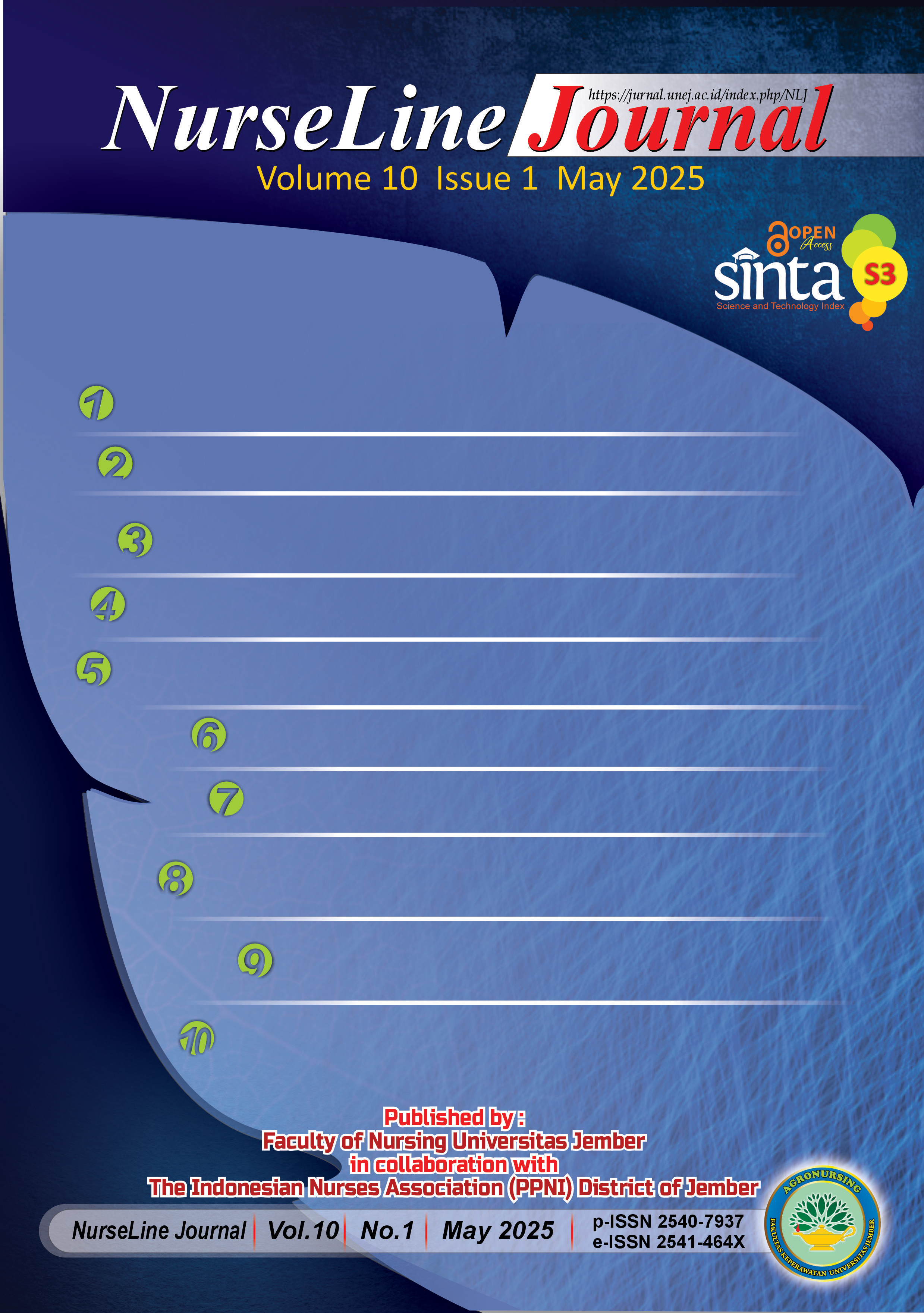A Self-Regulation Management Model to Reduce Pain and Cholesterol in Coronary Heart Disease Patients
DOI:
https://doi.org/10.19184/nlj.v10i1.53696Keywords:
Self regulation, Pain index, total cholesterol, coronary heart diseaseAbstract
Self-regulation management is the process of controlling and monitoring one's behavior to achieve specific health goals involving physical, cognitive, motivational, and social factors. In coronary heart disease (CHD) patients, self-regulation is essential for symptom management and improving quality of life. This study aimed to describe and analyze the pain index, lipid profile levels (total cholesterol, LDL, HDL, and triglycerides), and quality of life, while identifying which indicators significantly represent the self-regulation construct. A cross-sectional quasi-experimental design was employed, involving 195 CHD patients at Jombang Public Hospital. Data were collected through interviews, questionnaires, and laboratory tests. A one-tailed independent T-test was used to assess the significance of self-regulation indicators, comparing the T-statistic values of the measurement model with a T-table value of 1.65 (df = 194, α = 0.05). The results showed that only self-monitoring, self-diagnosis, and pain level had T-statistics exceeding 1.65, indicating a significant effect on the self-regulation construct. Recurrence and total cholesterol did not show a significant influence. Pain levels were lower in the treatment group (mean = 1.85, adjusted to 2 – moderate pain) compared to the control group (mean = 2.75, adjusted to 3 – severe pain). These findings suggest that targeted interventions enhancing self-monitoring and self-diagnosis may reduce perceived pain and strengthen self-regulation in CHD patients. These indicators should be prioritized in future intervention models for managing coronary heart disease.
Downloads
References
Al-Tamimi, M. A. A., Gillani, S. W., Abd Alhakam, M. E., & Sam, K. G. (2021). Factors associated with hospital readmission of heart failure patients. Frontiers in Pharmacology, 12(October), 1–9. https://doi.org/10.3389/fphar.2021.732760
Buurma, M., van Diemen, J. J. K., Thijs, A., Numans, M. E., & Bonten, T. N. (2019). Circadian rhythm of cardiovascular disease: The potential of chronotherapy with aspirin. Frontiers in Cardiovascular Medicine, 6(June), 1–7. https://doi.org/10.3389/fcvm.2019.00084
Cacciata, M. C., Alvarado, I., Evangelista, L. S., & Jose, M. M. (2021). Health determinants and risk factors for coronary artery disease among older Filipinos in rural communities. European Journal of Cardiovascular Nursing, 20(6), 565–571. https://doi.org/10.1093/eurjcn/zvaa039
Chovanec, M., et al. (2020). HFA discoveries abstract. European Journal of Heart Failure, 22, 2–415. https://doi.org/10.1002/ejhf.1963
Chrysohoou, C., Aggeli, C., Avgeropoulou, C., Aroni, M., Bonou, M., Boutsikou, M., ... Stavrati, A. (2020). Cardiovascular disease in women: Executive summary of the expert panel statement of women in cardiology of the Hellenic cardiological society. Hellenic Journal of Cardiology, 61(6), 362–377. https://doi.org/10.1016/j.hjc.2020.09.015
Dehghan Nayeri, N., Yadegary, M. A., Seylani, K., & Navab, E. (2019). Development and psychometric evaluation of coronary artery disease treatment adherence scale. Cardiology and Therapy, 8(1), 103–115. https://doi.org/10.1007/s40119-019-0135-4
Hariyono. (2021). Peningkatan kualitas hidup pasien penyakit jantung koroner: Self regulatory intervention. Disertasi.
Haynes, S. C., Tancredi, D. J., Tong, K., Hoch, J. S., Ong, M. K., Ganiats, T. G., ... Romano, P. S. (2021). The effect of rehospitalization and emergency department visits on subsequent adherence to weight telemonitoring. Journal of Cardiovascular Nursing, 36(5), 482–488. https://doi.org/10.1097/JCN.0000000000000689
Joseph, J. J., Deedwania, P., Acharya, T., Aguilar, D., Bhatt, D. L., Chyun, D. A., ... Sperling, L. S. (2022). Comprehensive management of cardiovascular risk factors for adults with type 2 diabetes: A scientific statement from the American Heart Association. Circulation, 145(9). https://doi.org/10.1161/CIR.0000000000001040
Lahoz, R., Fagan, A., McSharry, M., Proudfoot, C., Corda, S., & Studer, R. (2020). Recurrent heart failure hospitalizations are associated with increased cardiovascular mortality in patients with heart failure in Clinical Practice Research Datalink. ESC Heart Failure, 7(4), 1688–1699. https://doi.org/10.1002/ehf2.12727
Maynard, C., Weaver, W. D., Litwin, P. E., et al. (1993). Hospital mortality in acute myocardial infarction in the era of reperfusion therapy. American Journal of Cardiology, 72, 877–892.
Molina-Mula, J., & Gallo-Estrada, J. (2020). Impact of nurse-patient relationship on quality of care and patient autonomy in decision-making. International Journal of Environmental Research and Public Health, 17(3). https://doi.org/10.3390/ijerph17030835
Naylor, M. (2022). Discharge planning for hospitalized elderly. In T. T. Fulmer & M. K. Walker (Eds.), Critical care nursing of the elderly (pp. 331–344). New York: Springer Publishing Company.
Nursalam. (2024). Nursing management: Application in professional nursing practice. Jakarta: Salemba Medika.
Nursalam. (2024). Nursing science research methodology. Jakarta: Salemba Medika.
Parker, E. M., & Smith, C. M. (2010). Nursing theories & nursing practice (3rd ed., pp. 85–103). Philadelphia: F. A. Davis Company.
Parami, S., Tapak, L., Poorolajal, J., Moghimbeigi, A., & Ghaleiha, A. (2021). Identifying factors associated with the hospital readmission rate among patients with major depressive disorder. BMC Psychiatry, 21(1), 1–9. https://doi.org/10.1186/s12888-021-03559-7
Provencher, V., Amours, M. D., Menear, M., Obradovic, N., Veillette, N., Sirois, M., & Kergoat, M. (2021). Understanding the positive outcomes of discharge planning interventions for older adults hospitalized following a fall: A realist synthesis. [Nama jurnal tidak dicantumkan], 1–18.
Rodgers, J. L., Jones, J., Bolleddu, S. I., Vanthenapalli, S., Rodgers, L. E., Shah, K., ... Panguluri, S. K. (2019). Cardiovascular risks associated with gender and aging. Journal of Cardiovascular Development and Disease, 6(2). https://doi.org/10.3390/jcdd6020019
Rofi’i, H. (2023). Personnel factors in the implementation of discharge planning for hospital nurses in Semarang. Journal of Nursing, University of Indonesia, 89–94.
Sarvasti. (2022). Heart disease rehabilitation program. Surabaya: Husada Utama Hospital.
Suciana, Hengky, H. K., & Usman. (2021). Analisis faktor risiko penyakit jantung koroner pada penderita diabetes melitus tipe 2 di RSUD Andi Makkasau Kota Parepare. Jurnal Ilmiah Manusia dan Kesehatan, 4(2), 254–265.
Taylor, R. S. (2022). The role of cardiac rehabilitation in improving cardiovascular outcomes. Nature Reviews Cardiology, 19(March), 180–194. https://doi.org/10.1038/s41569-021-00611-7
Tjahjono, C. T., & Widito, S. (2020). Heart Science Journal, 1(July), 24–31.
Utara, U. S. (2018). Transitional care pada pasien gagal jantung di rumah sakit di Kota Medan: Preliminary study. TALENTA Conference Series.
Downloads
Published
Issue
Section
License
Copyright (c) 2025 NurseLine Journal

This work is licensed under a Creative Commons Attribution-ShareAlike 4.0 International License.








